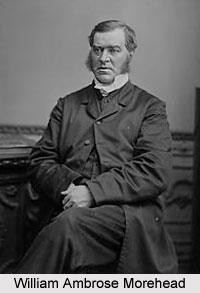 William Ambrose Morehead served as the Acting Governor of Madras Presidency for 2 separate terms in the year 1860 and again from 1860 to 1861, in the erstwhile undivided India under the rule of the British Empire. He was also a British colonial administrator. Morehead also served as one of the members of the British Indian Civil Service (ICS), which was the civil service of the Government of India during the era of the rule of British Empire in India. The members of the civil service were appointed under Section XXXII of the Government of India Act, 1858 of the Parliament of the United Kingdom. After the year 1886, the Indian Civil Service was officially known as Imperial Civil Service.
William Ambrose Morehead served as the Acting Governor of Madras Presidency for 2 separate terms in the year 1860 and again from 1860 to 1861, in the erstwhile undivided India under the rule of the British Empire. He was also a British colonial administrator. Morehead also served as one of the members of the British Indian Civil Service (ICS), which was the civil service of the Government of India during the era of the rule of British Empire in India. The members of the civil service were appointed under Section XXXII of the Government of India Act, 1858 of the Parliament of the United Kingdom. After the year 1886, the Indian Civil Service was officially known as Imperial Civil Service.
Early Life of William Ambrose Morehead
William Ambrose Morehead was born in the year 1805 in Edinburgh, to father Reverand R. Morehead. Charles Morehead, his brother, acted as Governor of Bombay Presidency. William Morehead successfully completed his education in United Kingdom. Later he passed the entrance examination and qualified for the British Indian Civil Service.
Career of William Ambrose Morehead
William Ambrose Morehead went to Madras (now Chennai) in British India in the year 1825. He was assigned as a Judge of the Sadr Court in the year 1846 and later in 1850. He later served as a member of the Madras Legislative Council from the year 1857 to 1862. He was eventually appointed as the Acting Governor of Madras Province for 2 terms between 1860 and 1861. He was preceded by Sir Charles Edward Trevelyan, 1st Baronet, KCB and took office on 4 August 1860. The Madras Presidency, also known as the Presidency of Fort St. George and Madras Province, was an administrative sub division of British dominated India. The territory included most of southern India, such as the modern states of Tamil Nadu, the Coastal Andhra and Rayalaseema regions of Andhra Pradesh, Lakshadweep Islands, the Malabar region of North Kerala, Koraput, Malkangiri, Nabarangapur and Gajapati districts of southern Orissa and the Bellary, Ganjam, Dakshina Kannada, Rayagada and Udupi districts of Karnataka.
He served in office till 18 February 1861 and was succeeded by Sir William Thomas Denison, KCB. He also acted as Vice Chancellor of the University of Madras. William Ambrose Morehead retired in October 1862. He died on 1st December 1863 in Edinburgh, United Kingdom.



















